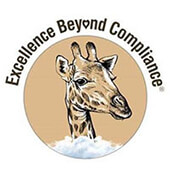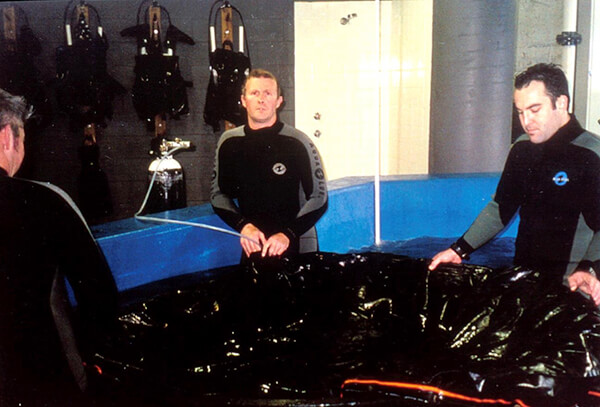Academy Contributors
Getting Better All the Time:
Leveraging Animal Welfare Act and USDA Information Resources to Do More for Animals
 By James F. Gesualdi By James F. Gesualdi
To keep ahead, each one of us, no matter what our task, must search for new and better methods, for even that which we now do well must be done better tomorrow.
—James F. Bell
Give me a lever and a place to stand, and I will move the world.
—Archimedes
Taking ownership of our responsibilities under the Animal Welfare Act (AWA) enables us to create more good practices to enhance animal welfare. The AWA and its regulations set forth certain specific legal requirements, but many of those are elastic, performance-based standards that allow much room for innovation and growth. The Excellence Beyond Compliance® approach details many of the opportunities that the AWA provides for zoological professionals and the zoological community. Recently updated and new U.S. Department of Agriculture (USDA) Animal and Plant Health Inspection Service Animal Care informational resources provide essential references. Recent developments relating to the agency's administration of the AWA have opened the door for the zoological community to proactively lead the way in demonstrating its extraordinary commitment to make the most of the AWA.
The agency has published an up-to-date version of the old "Blue Book" containing the text of the AWA and accompanying regulations. This is the essential starting point of awareness, since it spells out what the law and regulations require. A professional's electronic devices should contain this document, or at least the link to access or download it:
https://www.aphis.usda.gov/animal_welfare/downloads/AC_BlueBook_AWA_FINAL_2017_508comp.pdf.
This publication contains a comprehensive index, which, combined with the detailed section-by-section contents, makes it easier to search and to locate similar or related features across covered species.
Lifelong learners, problem solvers, and troubleshooting "detectives" can go substantially deeper, now that the agency has posted all the AWA-related Federal Register notices dating back to enactment in 1966. To better understand the meaning, import, purpose, or spirit of a regulatory requirement, the explanatory portions of the relevant proposed and final rules are simply a few clicks away. These are available here:
https://www.aphis.usda.gov/aphis/ourfocus/animalwelfare/sa_awa/awa_federal+register_notices.
Reviewing regulatory history can be enormously helpful and informative, and can be used proactively, although it is most often consulted when there are different perspectives relating to a regulatory standard.
Turning from the present regulations and historical background, the agency has also recently revised some portions of the voluminous and insightful Animal Welfare Inspection Guide (the "Guide"), available at:
https://www.aphis.usda.gov/animal_welfare/downloads/Animal-Care-Inspection-Guide.pdf.
The Guide is intended to help promote well-informed, consistent field inspections and associated reports. The Guide is chock-full of insightful guidance for regulated entities, including zoological professionals. In some instances, it can aid in understanding and breaking down specific regulatory requirements, as well as what the agency examines during an inspection. The recent revisions to the Guide relate to teachable moments: what constitutes "critical noncompliant items" (for example, items currently having a serious or severe adverse effect on the health and well-being of the animal, or having high potential to have that effect in the immediate future); documenting inspection findings, including those concerning indoor, sheltered, and outdoor housing; and identifying all types of inspections.
The agency's Center for Animal Welfare has posted many of the presentations from its March 2017 Nonhuman Primate Symposium, "Practical Solutions to Welfare Challenges," including topics such as behavior, environmental enrichment, health care, husbandry, health, and geriatric care. See
https://www.aphis.usda.gov/aphis/ourfocus/animalwelfare/caw/nonhuman-primate-symposium.
The Center's nonhuman primate specialist, Dr. Gwendolyn Maginnis, has a PowerPoint presentation titled "Developing an Environment Enhancement Plan," which is invaluable for primate caregivers (and others) developing or reviewing enrichment plans. Saint Louis Zoo Curator of Primates Heidi Hellmuth's "Just Listen—Giving Animals a Voice to Improve Their Quality of Life" is especially interesting, because it covers ways to further enrich animals' lives by empowering them to show us how to be better caregivers.
The much-heralded agency inspection report database—containing three years of inspection reports, other information, and useful search tools—remains offline. But 3 years of inspection reports that are at least 30 days old are now available online, for all regulated entities other than individual people, in PDF collections organized by state. To access them, go to
https://www.aphis.usda.gov/aphis/ourfocus/animalwelfare/sa_awa/awa-inspection-and-annual-reports,
scroll down to "Inspection Reports by License/Registration Type & State," scroll to "Exhibitor," select your state, and "View Reports." Here, you can download PDFs of all inspection reports that are available for your state. You will then need to scroll—page by page—to locate your inspection reports. Be certain to scroll through to the end of the document, since the most current inspection reports appear there.
Whatever happens with the database, the zoological community should voluntarily encourage individual zoological organizations to post all future final inspection reports (those no longer subject to appeal) on their own websites, accompanied by a general explanation of the information presented, and an update on any improvements undertaken subsequent to the inspection (regardless of whether they were required or not). If there are difficult or challenging circumstances described in an inspection report, this gives the zoological organization its first, best opportunity to caringly demonstrate its commitment to the animals and dedication to "getting better all the time." This is how leaders lead, by doing and demonstrating commitment to animal well-being, transparency, and the public trust.
A second federal court of appeals has upheld another challenge to the USDA's administrative AWA license-renewal process, which merely requires that annual reports are properly filed, the renewal fee is paid in a timely fashion, and the regulated entity renewing its license certifies compliance with the AWA. This latest decision upholds the USDA's practice as a reasonable interpretation of the AWA. Here, the zoological community has another opportunity to lead. Go further than simply stating/certifying compliance in license renewal forms: demonstrate it. Attach or enclose a copy of the most recent inspection report with your renewal. If there were any noncompliances (or if one wants to demonstrate doing more), include a certification that those items have been addressed, and possibly note and/or document that any completed or planned improvements are included or available upon request. Like posting your own inspection reports, this shows commitment to Excellence Beyond Compliance® and accelerates advances in animal welfare.
Finally, the USDA Office of Inspector General (OIG) released its much-anticipated audit of AWA oversight and enforcement concerning marine mammals. Although focused on marine mammals, there are a number of lessons for all zoological organizations. For example, the audit references the OIG's 2010 big cat safety study in the discussion relating to barriers, distance between animals and the public, and safety. The release of this latest audit can be used to prompt review and consideration of these features throughout your facility, including the potential for foreign objects to wind up in animal areas. Another item for broader consideration is the provision of shade.
For easy access to the above-referenced agency materials and resources, go to Excellence Beyond Compliance®
at http://excellencebeyondcompliance.com/links/.
Please email me at jfg@excellencebeyondcompliance.com to share the good you are doing (as only you can), or with any comments or questions on this column or suggestions for future ones. For upcoming workshops and sessions, contact: info@excellencebeyondcompliance.com.
© 2017 James F. Gesualdi, P.C. The opinions expressed herein are solely those of the author. This is not, nor should it be construed as, legal advice.
 Something Fishy Is Going On Something Fishy Is Going On
By Dr. Rob Jones, "The Aquarium Vet"
Previously, we talked about stingrays and their venomous spine (barb), and the risk they pose. To prevent problems, correct handling of rays is essential—and to be honest, I wish I could say I have all the answers. But I do not.
When handling any ray, it is essential to develop, with the HR/OSHA department of your facility, a safe working plan. This plan needs to examine and document which staff members will be involved, the level of experience and training they have in working with dangerous animals, and what role each person will play in the handling process. Such a plan requires open discussion among all parties involved. It then needs to be written down and agreed upon.
It is important to remember that most rays are covered in a very heavy mucous layer, which makes it difficult to grasp them firmly, and they are quite slippery to handle. If using nets, be very careful, since the tail and barb can poke through the gaps; and it is then possible for the barb to get caught on the net. It then has to be cut free, which creates a potential risk. Another option is to use "shields" made out of thin acrylic material, which can be used as a barrier between the rays and divers as the ray is herded to where it can be more easily handled.
Handling equipment that is made from a material originally developed for venomous snakes may assist, along with providing some personal protective equipment (PPE), including gloves, arm guards, and chest protectors.
Tonic immobility, as previously discussed with sharks, does not work well with rays and should not be attempted. Frequently, in handling, examining, or moving rays, it is best to use sedation/anesthesia, and veterinary assistance is then required. If possible, I transfer the ray to a solid tub (in an appropriate size for the ray), where the drug is then added to the water. By tipping the tub at a 30- to 45-degree angle, it is possible to have the rays swim in and then swiftly tip the tub back into a horizontal position. Water can be added or removed as needed. An airstone with oxygen will elevate the oxygen levels in the water, and an opaque tarpaulin over the top can provide safety, as well as settle the ray until the drug takes effect.

Sedating a 661-pound (300-kilogram) smooth stingray Dasyatis brevicaudata in a solid tub. Note the oxygen tubing in my hand and the black tarpaulin over the top.
Once the ray is sedated, handling and procedures become straightforward. It is a good idea to still cover the barb with either a wet towel wrapped around the whole tail, or a length of PVC pipe that is slid up the tail to cover the barb. If the ray needs to be handled repeatedly in the coming weeks—for example, if it needs regular tube feeding—I would trim the barb at this initial examination and handling.
Finally, just before the actual handling procedure, a verbal review of the working plan needs to be carried out. The various steps and roles should be described again, so that all present know exactly what their roles are. As always, please exercise common sense and be careful at all times.
In September, The Aquarium Vet will be in Indianapolis for the AZA national conference. Please come and see us at Booth 506. We would love for you to drop by and say G'day.
E-quarist™ Courses—Academy Subscriber Special!
The San Diego Zoo Global Academy is excited to share an additional Academy subscriber benefit regarding our collaboration with Dr. Jones: as an Academy subscriber, you are now entitled to a discount on the e-quarist™ courses.
For more information about the SDZGA discount, or to view our Trial Version, please contact katrina@theaquariumvet.com.au
Visit the Aquarium Vet website at theaquariumvet.com.au.
|